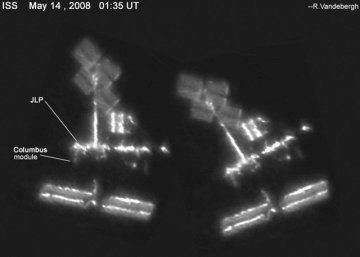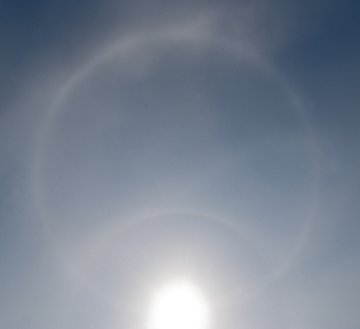| FLYBY ALERT! Space shuttle Discovery launches on May 31st. Get your flyby alerts from Space Weather PHONE | | | 100 EXPLOSIONS ON THE MOON: NASA astronomers have been watching the Moon to see how often meteoroids crash into the lunar surface and they've just video-recorded their 100th explosion. This bountiful data-set allows researchers to start drawing conclusions about when, where, and how hard the Moon gets hit. Get the full story and a video from Science@NASA. ISS MARATHON: The 2008 "ISS Marathon" is underway . For the next three days, the International Space Station will be in almost constant sunlight. This means sky watchers in Europe and North America can see the spaceship gliding overhead as many as four times each night. When should you look? Click here. The ISS is not only a beautiful naked-eye object, but also it makes a fine target for backyard telescopes: 
This is the view through a 10-inch Newtonian. Ralf Vandebergh took the picture on May 14th when the ISS appeared over his home in the Netherlands. As the bright spacecraft glided slowly overhead, "I tracked the ISS by hand using the telescope's 6x30 finderscope," he explains. On May 31st, space shuttle Discovery will launch and later rendevous with the ISS. Discovery's mission is construction: the crew will deliver and install a huge (37 feet x 14 feet) Japanese laboratory with its own robotic arm. The new Kibo Pressurized Module will be attached to the point marked "JLP" in Vandebergh's photo, making the ISS even bigger and brighter than it is now. Something to look forward to.... more images: from Sabahattin Bilsel of Erenkoy, Istanbul, Turkey; from Ugur İkizler of Mudanya, Bursa, Turkey; from P. Nikolakakos of Sparta, Greece; from Giuseppe Pappa of Mascalucia, Sicily, Italy; from J. Stone of Auburn, Alabama; Space Station Flyby Times PARHELIC CIRCLE: While most ice haloes we see go around the sun, there is one that goes right through it: the parhelic circle. "For a few minutes on the afternoon of May 19th, cloud conditions were right to form both a 22° halo around the sun and a perfectly-defined parhelic circle," reports Alan Dyer who took the photo, below, from Alberta Canada. "This produced a sky filled with two intersecting halos--a rare sight." 
"Now is a good time of year to see parhelic circles because they appear high in the sky," notes atmospheric optics expert Les Cowley. "The altitude of the circle always matches the altitude of the sun, hugging the horizon in winter and rising high overhead in summer. The higher the sun, the smaller is the circle, and it can even shrink smaller than the 22o halo seen crossing it in Dyer's photo. Almost all types of ice crystal carve the parhelic circle, it looks very simple but it is made in more ways than any other halo." Parhelic circles are pale white like the icy clouds that make them. "Look carefully to distinguish it from white clouds," urges Cowley. "With luck you will see a complete circle." more images: from Aymen Ibrahem at the Bibliotheca Alexandrina in Alexandria, Egypt; from Enzo De Bernardini of Martínez, Buenos Aires, Argentina; from Stanislaw Rokita of Torun, Poland; from Marco Candotti of Palmanova, Friuli, Italy;
April 2008 Aurora Gallery
[Aurora Alerts] [Night-sky Cameras] | 
